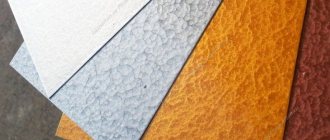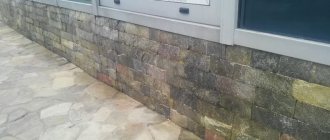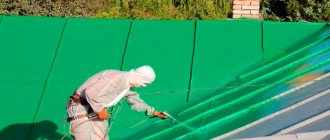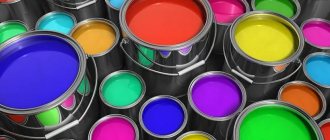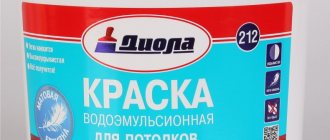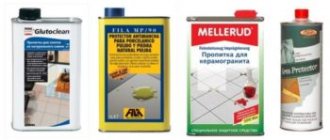For those who love to surround themselves only with natural materials, today it is not at all necessary to spend huge sums of money on the purchase of expensive, but difficult to install materials.
The modern construction market will offer consumers a wide range of paints and coatings that have almost all the characteristics inherent in materials of natural origin.
Those who have little money may like natural stone effect paint, which can adequately create the illusion of a natural finish. Moreover, such an imitation can be so plausible that it will not differ from the original either tactilely or visually.
Description of KM
It is visually and tactilely difficult to distinguish an imitation stone from the original. In finishing work, this material is often used by those with a medium budget.
In construction, stone paint began to be used relatively recently. But the material has become a favorite among specialists and home craftsmen because of the ease of working with them and their ability to apply to any surface. They work with it at home independently without the help of professionals. The surface acquires a reliable stone structure.
The coating is characterized as reliable, durable, and can withstand various types of loads, including mechanical and physical impacts. Thanks to KM, the surface is decorated like rough cave stone or palace marble.
This is a material for external and internal use. Therefore, it is considered not only as a decorative coating, but also as a covering layer with protective qualities.
Required Tools
Decorating the surface with plaster indoors or on the facade is the most promising type of finishing. To do this you need to choose the right set of tools:
- a suitable container for mixing the solution (when purchasing dry mixes);
- electric mixer;
- rule;
- spatula with trowel;
- steel graters with a width of 200 to 250 mm;
- building level;
- bush hammer;
- boaster;
- mold or matrix;
- rags.
In addition, for marking you will need a tape measure, a pencil (marker), and masking tape. Also, do not forget about basic safety measures, in particular – overalls, shoes, gloves. If necessary, wear a hat and glasses.
To apply the solution and create texture you will need a set of tools
Area of use
A coating with an imitation of natural material is used for various types of finishing, applied to residential and non-residential housing construction projects, and decorates elements of land plots. Its use solves various issues:
- This is a material for finishing interior elements inside the house and for giving the facade respectability. Elements of the personal plot are decorated (the fence, gazebo, flower beds, paths are painted);
- there are no problems with interaction with the base. Different types of walls are painted;
- due to its strength characteristics, it is possible to paint floors and stairs to look like stone;
- The apron in the kitchen and furniture elements are decorated. This is how the style of the house is maintained;
- The CM-covered fireplace and stove look beautiful and original;
- The concrete base will get an expensive appearance, the painted tiles will look rich and solid.
Errors when simulating masonry.
Do-it-yourself stone imitation differs from a professional one only if serious mistakes are made:
- Uneven drawing. The “masonry” should be level, the general direction of the longitudinal edges of the stones should be strictly horizontal.
- Scales. A relief that looks like scales is a sign of unprofessionalism, since stonework of this shape does not exist in reality.
- The accuracy of the shapes of the stones does not have to be perfect: the stones do not rub against each other. Therefore, you should not be afraid to make wider depressions in the places where the ends of two stones are connected.
- Roughness. “Burrs”, small pellets must be cleaned off.
Otherwise, imitation of stone with plaster is no more difficult than any painting and plastering work and can be performed by a non-professional of any level. Especially if this work is done for oneself: shortcomings are forgivable, but the work is exciting and interesting.
Compatibility with other materials
The demand for CM is explained by the fact that manufacturers produce stone-effect paint that interacts well with many building materials. The dye is applied to the surface:
- treated with plaster;
- concrete and foam concrete base;
- plastic;
- composite materials;
- wood;
- glass;
- drywall;
- polyurethane;
- metal;
- covering tiles and ceramics.
Stone-look paint in cans is used to decorate large and small elements of landscape design. For example, crushed stone used to create paths is covered.
Unusual dyeing products
Drying oil for impregnation of gypsum coating Source kraski-net.ru
Coloring gypsum stone with rosin Source ozone.ru
Colored stain for decorating artificial gypsum stone Source insales.ru
- Drying oil. The main areas of its use are the base for paints and wood impregnation. When applied to a plaster coating, it creates an unusual effect of aged stone in warm beige-brown tones.
- Rosin and varnish. These two substances, when mixed with technical alcohol, can color light plaster into a brownish-red color, reminiscent of old ceramics.
- Stain. This compound is also commonly used on wood, but can be used just as well on plaster. The stain is available in various shades of red-brown colors.
Paint brands from manufacturers
A dye belonging to this group of paints can imitate granite, marble, and many other natural stones. It's not difficult to work with him. At the same time, it looks good in combination with other types of paints.
Among many proposals from manufacturers, the following compositions were tested for the strength and effectiveness of the coating:
- Decorative varnish, creates the effect of small cracks on the surface Sherwin Williams Faux Impressions Crackle, manufactured in the USA.
- An innovative coloring material that has a high degree of adhesion to any surface Faux Impressions Dimensional Basecoat. KM lays on so easily that it is applied to the surface with a roller, USA manufacturer.
- To paint indoor walls, doors, interior items, furniture with color and texture effects, a liquid latex vinyl-acrylic glaze coating is used - Sherwin Williams Faux Impressions Latex Glaze, USA.
- Paint with the effect of quartz stone was created using innovative technology - Faux Impressions Quartz Stone, USA. A coating with a characteristic shine of quartz is formed. Apply with a roller.
- KM Faux Impressions Metallic, USA is a composition that has a metallic shine.
- Paints that imitate Venetian plaster are recommended.
- Texture coatings are applied to match the material of nature.
Dyeing process
A set of brushes of different sizes for painting gypsum stone Source zubr-vrn.ru
Spray gun for painting gypsum decorative stone Source gidpokraske.ru
To apply paint, you can use brushes or a spray gun or an airbrush. A roller is not suitable for such surfaces, especially if the stone is already painted on the walls. This tool will not be able to achieve a smooth and uniform coating, and unsightly streaks will form in the spaces between the tiles.
Applying paint to gypsum decorative stone using an airbrush Source gidpokraske.ru
The dyeing technology itself does not differ significantly from that for other types of finishing materials:
- The paint is applied gradually, from bottom to top, with a convenient brush of suitable width. It is important to add neither too much nor too little mixture so that you get an even layer of color without drips.
- Using a spray gun, paint is also applied from bottom to top, from a distance of 30-50 cm from the wall. Remember that the closer you hold the device, and the longer you hold it in one place, the thicker and brighter the color the paint layer will be.
- The varnish can be purchased already in a spray can or also poured into a spray gun. Or you can use a brush, preferably a fairly wide one.
- Stain, drying oil and rosin are more convenient and easier to apply with a brush.
Pros of using CM under stone
The main qualities that are a priority when choosing such a CM are its resistance to abrasion, mechanical stress and other strength characteristics.
The covering layer is waterproof and dirt-repellent. It is washed with water.
Under the influence of the sun's UV rays, the brightness of the color is not lost, the quality of the coating remains at the original level.
The applied material hides defects on the surface and protects it throughout its service life. The composition is frost-resistant and is an environmentally friendly product.
Thanks to the variety of textures and shades, a coating is created that will decorate any interior. At the same time, the price of KM is affordable for the average buyer.
Technique for applying paints and varnishes
Those who have decided to decorate their own objects with such paint and varnish material can be guaranteed to receive the desired colors, textures and even inclusions that can often be found in natural stones. In order to obtain such an imitation of an artificial stone surface that even a professional cannot distinguish from a natural one, certain application recommendations must be followed. So, first you need to clean and wash the surface on which the paint will be applied. Concrete or plaster composition that contains cement is best washed under water pressure from a hose. To ensure the surface has maximum adhesion, it should be sanded in advance. The surface of the floor and walls that have been exposed to moisture must be thoroughly dried for at least 3 days. After perfect drying, be sure to use the priming mixture.
Please note that at the very end you should apply a paint composition, to which you can optionally add glitter for maximum decorative effect. Lastly, the slightly dry layer of paint needs to be varnished.
To obtain a beautiful, solid and modern interior, it is not at all necessary to use materials that are difficult to apply and are expensive. The long-standing desire to create an exterior or interior made of stone can be easily realized using affordable paints that fully and efficiently imitate materials of natural origin.
